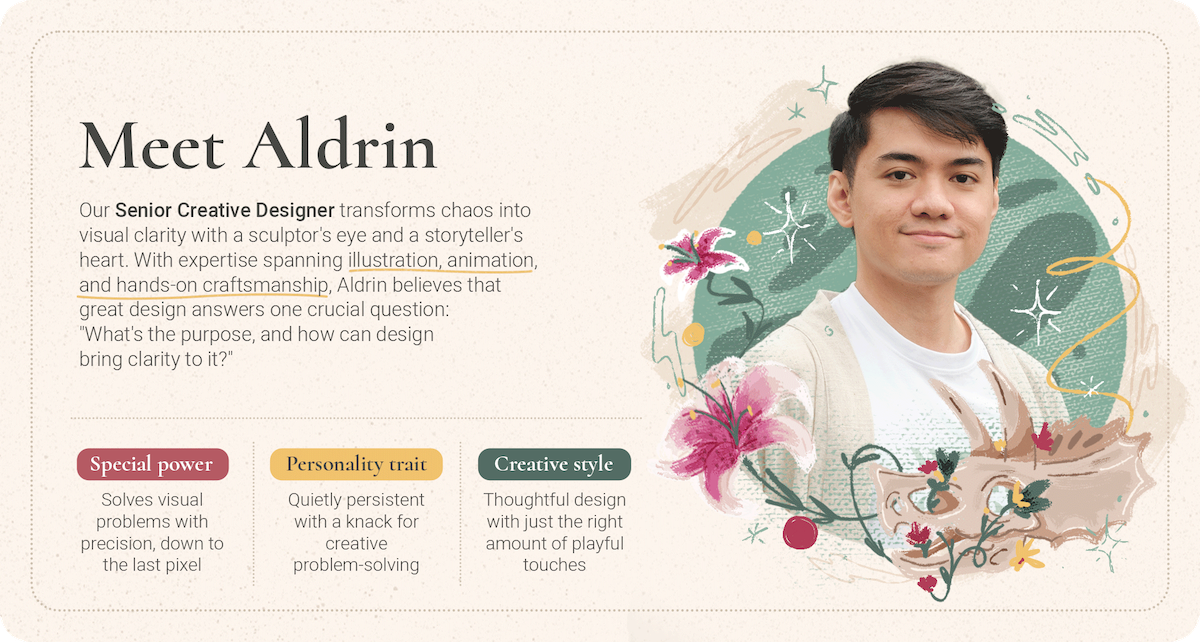
We live in a hyper-connected world where people expect information to be available at the click of a mouse button.
Best rendang recipe? Click.
Second President of Singapore? Click.
Price of the S&P 500? Click.
In these times, it’s easy to forget that the world’s most vital information may actually be locked inside someone’s head. For instance, you might want to hear a war veteran’s personal experiences, a virologist’s thoughts on a new pandemic making the news, or how two young creatives created a brand dominating the personal finance world.
Getting access to such opinions or data points takes more than just clicking buttons or putting together search strings. But these unique insights give your content the expertise and authority to edge out the competition.
Interviews are a vital way to uncover such information, but are often underutilized in today’s age of instant digital gratification. This is a pity, because all it takes is an hour, the right interview subject (an expert, or someone with relevant personal experience), and an interviewer with the right skills and preparation.
The resulting process will unlock more than just facts and numbers, but also mindset, intention, and emotion—all often lost in translation in a simple text questionnaire.
Why bother with interviews when I can Google it?
Great interviews are a gift for savvy content creators, who know that quality content depends on the expert thoughts and human dimension that only person-to-person conversations can convey.
Because that’s what interviews are: conversations.
By definition, conversations happen between two human beings; the human element elevates any content it inhabits, whatever purpose the content serves in the end. Human interest can enliven even the most strait-laced corporate content when spiced with personal reflections from stakeholders.

Good interviews don’t coast on human interest alone, of course.
Content also earns legitimacy from the right interviews, especially if they come from a highly-placed executive or a subject-matter expert.

Properly vetted, well-researched interviews can take a deep dive into an interviewee’s subject-matter expertise and extract quotes that yield incomparable industry insider insights. These interviews sometimes provide surprising sound bites that you build your content around, and use to gain wide mileage on social media.
Interviews can also be solid gold from a content marketing perspective. As these interviews are one-off, unique compositions (read: not parroting previously-published content), the resulting content is more likely to be identified by Google as unique and authoritative—and hence worthy of a higher ranking.
What type of articles would most benefit from interviews?
More than any other form of content, profile articles are the ultimate way to connect the human experience to a corporate product or institution—and thus depend wholly on the right combination of interviewer and subject to get it right.

An in-depth interview profile can put a face to the people behind large institutions or those who benefit from their services. By highlighting the human side of a company, a personality profile can drive home a message about the company’s purpose and operations. Readers can better identify with the interviewee, and by extension, the company they’re associated with.
Interviews can be used to support thought leadership articles. By interviewing several sources, you can use their quotes to build your article’s narrative. For instance, you can structure the article in such a way that not only conveys the information you need, but clearly takes opposing views into account (for instance, you might interview people from opposing sides of an issue and build a back-and-forth exchange).
You can also use interview quotes to augment guide-style content. For example, quotes from a product manager or power user provide down-to-earth, relevant advice that can be applied immediately.

The human element in the advice provided can lighten what might be a heavy-going step-by-step process.
How to get the most out of an interview
The success of an interview depends on the interviewee’s chattiness, the interviewer’s conversational ability, and the degree of trust between the two.
The first and last are beyond the interviewer’s or content creator’s control. But you can follow a few simple rules of thumb that, when implemented over time, can hone your interview skills and make each interview conversation a success:
1. Do your homework
Going in cold or uninformed will only ensure failure, frustrating your interviewee and, at best, eliciting only surface-level answers that might as well just have been Googled elsewhere.
Days before the interview, learn what you can about the interviewee before you even set the appointment.
Beyond a simple Google search of the interviewee, look at their LinkedIn page and other places they may have been mentioned. Do they make YouTube videos? Have they been interviewed on a podcast—or better yet, do they have a podcast of their own? Do they write articles on the regular?
Read up about their company as well. Beyond Googling the business, you can check out their website, or search for press releases and news clips that mention the interviewee’s place of work.
When raiding these sources, look for the following bits of information:
- Their relevant experience with your topic
- Interesting human interest factlets that are relevant to the content
- Their previous thoughts/writing on the subject matter you’re interviewing them on
- Surprising/contrary opinions on the subject matter
- Their personal and work history
Then use your research to craft relevant and concise questions.
Note that there’s no need to write down every possible question; this might kill any spontaneity that otherwise might sustain the conversation. Instead, be ready to ask follow-up questions as they occur to you in the moment.
Remember: you’re leading a conversation, not an impersonal survey. Use the questions as a way to guide the flow of the conversation; you don’t have to ask them in a specific sequence, but feel free to ask out of sequence if it makes the conversation sound more natural.
Certain types of questions get better and more relevant answers than most. Review your questions against these common interview dos and don’t’s:
| Good Questions | Bad Questions |
|---|---|
| Questions related to experience or background e.g. Why did you leave your previous job? | Closed-ended questions that can be answered with “yes” or “no” e.g. Do you meet with fellow doctors every day? |
| Expertise-related questions e.g. What sets this new antibiotic drug apart from similarly-priced ones? | Vague questions e.g. What is happening in the finance sector these days? |
| Relevant personal questions e.g. What got you interested/personally invested in the topic? | Irrelevant/too personal questions e.g. Are your parents proud of you? |
Finally, should you send your questions to the interviewee beforehand?
In our experience, yes, absolutely. This gives them an overview of the conversation you’ll be having, and allows them to prepare and provide more in-depth answers to your questions.
2. Establish trust
As we talked about earlier, a conversation is simply two people exchanging information—but there’s a little more to this than data exchange.
Conversations carry elements of trust and interest: the interviewer’s job, in the moment, is to gain their trust, and use that trust to elicit more information from the subject.
Trust is absolutely essential to the interview process. An interviewee is putting themselves at the mercy of an interviewer, making themselves vulnerable to a degree, so interviewers must take care to use that trust to produce results. A distrustful interviewee will only yield perfunctory answers, while a trustful interviewee will be generous with their response.

That’s why you should always go out of your way to build trust. Providing questions beforehand, for instance, or demonstrating attention when interviewing (well-placed “hmms” and “OK” that let them know you’re listening with interest, without breaking the flow of the conversation).
That’s also why you should work hard to make your questions as uniquely relevant as possible, displaying intimate knowledge of your interviewee’s background. All these are exercises in gaining the unspoken trust of your interviewee.
3. Pull out key points
Once you’ve transcribed the interview afterward, look for the most important points that stand out in the copy. Look for statements that
- are most relevant to your subject matter,
- reframe the subject matter in a new or contrary way,
- are short but funny, thought-provoking, and succinct, or
- provide an emotional dimension to the content.
I personally prefer to edit the transcript first—removing repetitive sections, cleaning up grammar, and improving punctuation and flow.
 This writer uses sonix.ai to transcribe and edit interviews.
This writer uses sonix.ai to transcribe and edit interviews.
Through this process, I can already spot worthy excerpts and quotes, and often end up with a readable Q&A document that can be easily referred to and raided for more quotes as the drafting process goes on.
Tools of the trade
If interviews are conversations, then anything that gets in the way of conversations are, by definition, bad tools.
Thankfully, today’s technology works in the background to record and transcribe the interview’s back-and-forth, allowing you to focus on keeping the interview on track without any distractions.
For face-to-face conversations, for instance, a sound recorder on one’s smartphone can do the trick. For Google Meet or Zoom, any number of recording apps will work, depending on your laptop operating system; or each application’s native recording function.

This writer uses Wondershare Filmora to record conversations via screen capture, then uploads the audio file to sonix.ai to transcribe the interview. Today’s AI-based transcription apps, like Sonix or Otter.ai, do an excellent job at transcribing clear recordings—meaning you’ll never have to manually transcribe interviews again!
(Speaking of trust: always let the interviewee know beforehand that you’re recording!)
The human factor is your secret weapon
Great content depends on human interest. That’s what makes interviews such a wonderful weapon in the content arsenal: not only are they a great way to research a particular topic, they’re also an effective method to capture the human connection that drives a client or company’s purpose.
However, great interviews do not come out of nowhere.
Getting them right takes trust and plenty of practice. With both elements in good measure, you can eventually produce good interviews on the regular that get to the heart of a subject, with added emotion, humor, and insight to boot.
—
200+ industry-leading tech companies in Southeast Asia are happy clients of With Content. Join them and start delivering valuable content to your potential customers today.



